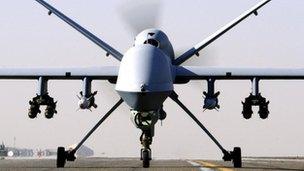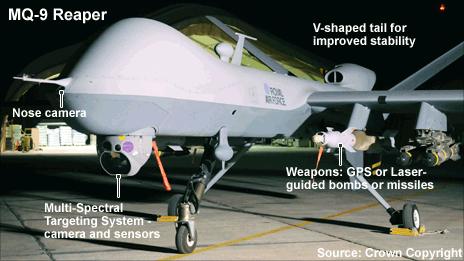Drones playing 'more important role'
- Published

The MoD says the UK's Reapers are used solely over Afghanistan as part of the war there
Drones have been used by the US and British military for many years, but are now fast becoming the focus for anti-war campaigners in both countries.
Reaper aircraft were first brought in by the RAF for surveillance and reconnaissance missions over Afghanistan, but were later armed so they could also fire missiles and drop bombs.
The Ministry of Defence insists that they do so only rarely, and that the vast majority of missions - believed to be about 95% - remain surveillance for UK and coalition troops.
It also stresses that the UK's Reapers are used solely over Afghanistan as part of the war there - unlike US drones, which are also used under the controversial doctrine of "pre-emptive self-defence", for targeted killings over countries such as Pakistan and Yemen.
The RAF is not keen on the term "drone". It prefers the use of Remotely Piloted Air Systems to make clear that these are not autonomous systems: they still need a human being to fly and command the mission - and crucially, decide whether or not to use weapons, and whether a strike can take place under the UK's rules of engagement.
But drones are playing an increasingly important role in air warfare, with many saying the Joint Strike Fighter is likely to be the last manned fighter aircraft bought by the UK.
After that, there will be no more "magnificent men in their flying machines", as the song had it.
"If you want precision and discrimination, these surveillance machines offer it," says aerospace analyst and former RAF pilot Andrew Brookes of the Air League.
"They can stay in the air for 16 hours at a time, and allow you to watch for hour after hour to make sure you are getting the right guy. And the UK is very strict about its rules of engagement."
However, he worries that drones such as Reaper will have more limited uses for the RAF after British combat forces leave Afghanistan by 2015, as they require air superiority to operate without being shot down.
"This could mean that we're buying 'fashion items' that will end up in the remainder bin after Afghanistan," he says.
But it is the idea of being able to use a machine to kill other human beings from the comfort of a chair thousands of miles away, using a screen reminiscent of a video game, that has galvanised campaigners in the US and Britain against drones.
Many feel that they have been introduced with little public debate.
They worry about the international legal framework and what will happen when their use becomes even more widespread.
Others fear future warfare in which much more autonomous machines could be used, with far less human decision-making at the point of taking a life.

The debate over which laws govern the use of drones and the taking of lives far away from a recognised international conflict has raged ever since the CIA used an armed Predator drone in Yemen in 2002 to kill al-Qaeda members, who were not fighting on any recognised traditional battlefield.
Although it was not made clear to the public at the time, the US had indeed designated Yemen as a conflict zone over which it was able to conduct CIA drone missions to defend America.
UN report
President Obama's administration has used legal opinion to allow it to continue the use of drones against those it deems suspected threats to the US in places ranging from Pakistan and Yemen to Somalia.
The UN is due to report back later this year on the US use of drones but has already made clear its belief that US strikes in the tribal areas of Pakistan violate international law.
The UK has used its military drones and pilots only in areas acknowledged as conflict zones such as Iraq, Libya and Afghanistan, while RAF drones do not take part in the CIA programme.
However, there are questions over whether British intelligence agencies helped offer targeting information to the US agency.
The laws of armed conflict have developed over centuries but the clear-cut distinctions of international state on state warfare, in which uniformed combatants are bound by the Geneva Conventions and face each other on battlefields, are not as easy to draw in an age in which the enemy may not wear uniform, be on any defined battlefield and can switch rapidly from civilian to fighter and back again.
- Published31 January 2012
- Published23 October 2012
- Published16 September 2012
- Published25 June 2012